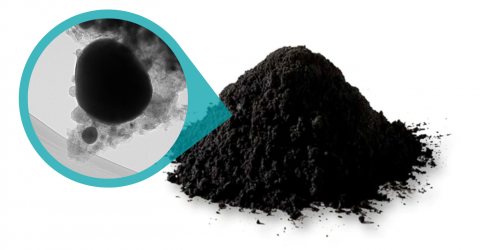BIOGAS AND BIOMETHANE
At Smallops we have opted for bioenergy, specifically biogas and biomethane, since it is a sustainable way of managing the solid waste generated in the world. In addition, this type of power generation has the advantage that it is largely independent of inclement weather, unlike other renewable energy such as solar and wind.
GET YOUR BUDGET
Get in touch with us and we will make you a personalized budget. If you have any kind of doubt, ask us about our references and you will know that other companies already trust Smallops to acquire their Fe nanoparticles.
WHAT IS BIOGAS
According to AEBIG (Spanish Biogas Association), biogas is a fuel gas whose main components are methane (CH4, between 50 to 70% vol.), carbon dioxide (CO2 between 30 to 50% vol.) and other components in smaller proportions. Methane, the main component of this gas, is what gives it its characteristic fuel. Its energy value, therefore, will be determined by the methane concentration – around 20 to 25 MJ/m3, compared to 33 to 38 MJ/m3 for natural gas (Werner et al 1989).
Biogas is generated by the microbiological decomposition of biodegradable organic matter under anaerobic conditions (lack of oxygen). “Agroindustrial biogas” is defined as gas generated from agroindustrial substrates, such as e.g. livestock manure, sludge from agri-food industries, crop residues, energy crops, etc.
WHAT IS BIOMETHANE
Biomethane or renewable gas is a fuel gas with a high concentration of methane, which is obtained from biogas. For certain uses of biogas, such as injecting it into a natural gas network or using it as fuel for vehicles, it must undergo a purification process. The process involves removing carbon dioxide from its composition, thus increasing the percentage of methane gas. Generally, the methane content reaches 96%, so it meets the criteria for use as natural gas. From this moment on, biogas has been called biomethane.
The composition and energy of biomethane are very similar to natural gas, so it can be used for the same purpose, such as injecting it into a natural gas network and using it as natural gas in different proportions or as fuel for vehicles.
USES OF BIOGAS
There are other applications in which energy use is greater. For example, purifying this gas until it becomes biomethane by eliminating its carbon dioxide (CO2) content, in such a way that it has qualities very similar to those of natural gas. Biomethane can have the following applications:
- Injection into the natural gas network
- Biofuel
- Combustion in cogeneration engines
USE OF IRON NANOPARTICLES (OPS) TO IMPROVE ANAEROBIC DIGESTION
In Smallops we have developed an additive. This additive serves to increase the yield of biogas and biomethane production, they are carbon-encapsulated iron nanoparticles called OPS. OPS help to improve biogas production, acting directly on the digester itself without altering the current process for obtaining this renewable energy and without having to use other substrates.
COMPETITIVE ADVANTAGES OF OPS
BIOGAS PLANTS
Thanks to OPS biogas plants improve the production of methane (CH4) by between 10-20%, in such a way that they increase profits since the resulting biogas would be of higher quality.
Thanks to the use of our nanoparticles, gas production is increased by 10-20%, that is, in the same reaction time the plants will obtain 10-20% more biogas. This means that if a biodigester of an E.D.A.R. (Wastewater Treatment Plant) of medium size annually generates 477,127 m3 of methane, applying our product would generate 524,839 m3 of methane per year.
An increase in the useful life of cogeneration engines has been demonstrated thanks to the elimination of hydrogen sulfide gas (H2S) by 99%, which is corrosive to biogas combustion engines, as well as being the cause of the characteristic smell of «rotten eggs».
The resulting digestate would have greater interest and viability when applying it in cultivation soils due to the higher content of iron and sulfur (essential nutrients for plants) and its lower pollutant load, which is an added value that would increase on the other. via the profitability of the process.
It has been shown that thanks to OPS the digester is stabilized against variations in the substrate. This is due to the fact that biogas production would be more constant and homogeneous, as well as being of higher quality and maximizing its production.
The use of OPS increases the degradation of phytotoxic compounds such as polyphenols by 24%.
Download a summary
Use of Iron Nanoparticles
Smallops iron nanoparticles are an innovative solution designed to improve biogas production in anaerobic digestion processes. Follow these steps to use iron nanoparticles and maximize their benefits in biogas production:


OPS dosage calculation
We determine the precise amount of iron nanoparticles needed to achieve the desired goal in biogas production. This will be based on digester volume and specific improvement goals.



OPS Dosage
Start the process by adding the iron nanoparticles directly to the digester, along with the substrates used in the anaerobic digestion process.


Monitoring and Adjustments
Regularly monitor the results of the biogas production process, paying attention to changes in the quantity and quality of the gas produced. We help you make adjustments as necessary based on the results obtained. Iron nanoparticles can have an impact on the speed and efficiency of biogas production.

HOW TO USE OPS

DO YOU NEED MORE CONFIDENCE?
LET'S START WITH SOMETHING SMALLER
You have the option of testing in your own laboratory or taking advantage of our laboratory and team of specialists.

TEST THE PRODUCT
If you are interested in trying our product, contact us. We will solve all your doubts and we will provide you with all the information you need.
We are just a click away!

